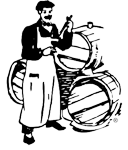"My admiration for this seven-hectare estate in the hamlet of Quintaine grows every passing year. As I've written before, Pierrette Guillemot's father was one of the founders of the Viré-Clessé cooperative, but she and her husband, Marc, elected to quit in 1985, converting first to organic and then, in 1991, to biodynamic farming. In 2013, their daughter Sophie joined the team; followed by her husband, Gautier Roussille (author, inter alia, of an impressive guide to Sake). All of the domaine's holdings are planted with massal selections of Chardonnay, with the oldest vines dating back to 1918. Like their neighbors, the Thevenets, the Guillemots harvest ripe grapes, fermenting and maturing the wines on the lees at their own pace. Botrytis, a relatively common occurrence due to Quintaine's humid mesoclimate, is embraced. These are honeyed, concentrated wines that are imbued with remarkable concentration and energy and develop beautifully in the cellar. Their strong personality is a world away from the insipid and ephemeral whites that shape many consumers' perceptions of the region, but that is precisely why they merit attention. Anyone visiting the domaine can't fail to be struck by the meticulousness that the Guillemot family bring to all their endeavors—whether it's their vegetable garden, their immaculately restored farmhouse-winery, or their wines. But of course, it isn't necessary to visit—you can taste the results in the glass. – William Kelley"
- The Wine Advocate (August 2021)


